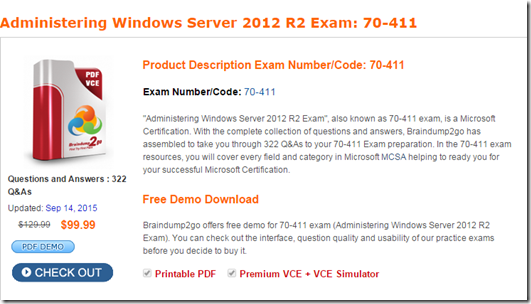MICROSOFT OFFICIAL: New Updated 70-411 Exam Questions from Braindump2go 70-411 PDF Dumps and 70-411 VCE Dumps! Welcome to Download the Newest Braindump2go 70-411 VCE&PDF Dumps: http://www.braindump2go.com/70-411.html (322 Q&As)
Get Prepared with fully updated Microsoft 70-411 Real Exam Questions and Accurate Answers for 70-411 Exam Dumps. Braindump2go IT experts review the 70-411 newly added qustions and suggest Correct Microsoft 70-411 Exam Questions Answers in Real Time. 100% Pass easily!
Exam Code: 70-411
Exam Name Administering Windows Server 2012
Certification Provider: Microsoft
Corresponding Certifications: MCSA, MCSA: Windows Server 2012, MCSE, MCSE: Desktop Infrastructure, MCSE: Private Cloud, MCSE: Server Infrastructure
Keywords:70-411 Dumps,70-411 Microsoft Exam Questions,70-411 VCE,70-411 PDF,70-411 Practice Exams,70-411 Practice Tests,70-411 Book,70-411 Study Guide

QUESTION 281
Your network contains an Active Directory forest. The forest contains two domains named contoso.com and fabrikam.com. All of the DNS servers in both of the domains run Windows Server 2012 R2.
The network contains two servers named Server1 and Server2. Server1 hosts an Active Directory-integrated zone for contoso.com. Server2 hosts an Active Directory-integrated zone for fabrikam.com. Server1 and Server2 connect to each other by using a WAN link.
Client computers that connect to Server1 for name resolution cannot resolve names in fabrikam.com.
You need to configure Server1 to resolve names in fabrikam.com.
The solution must NOT require that changes be made to the fabrikam.com zone on Server2.
What should you create?
A. a secondary zone
B. a stub zone
C. a trust anchor
D. a zone delegation
Answer: B
Explanation:
A stub zone is a copy of a zone that contains only those resource records necessary to identify the authoritative Domain Name System (DNS) servers for that zone. A stub zone is used to resolve names between separate DNS namespaces. This type of resolution may be necessary when a corporate merger requires that the DNS servers for two separate DNS namespaces resolve names for clients in both namespaces.
QUESTION 282
Your network contains an Active Directory domain named contoso.com.
Network Access Protection (NAP) is deployed to the domain.
You need to create NAP event trace log files on a client computer.
What should you run?
A. Register-ObjectEvent
B. Register-EngineEvent
C. tracert
D. logman
Answer: D
Explanation:
Register-ObjectEvent: Monitor events generated from .Net Framework Object. Register-EngineEvent: Subscribes to events that are generated by the Windows PowerShell engine and by the New-Event cmdlet.
http://technet.microsoft.com/en-us/library/hh849967.aspx
tracert: Trace IP route
logman: Manages and schedules performance counter and event trace log collections on a local and remote systems.
http://technet.microsoft.com/en-us/library/bb490956.aspx
QUESTION 283
Your network contains an Active Directory domain named contoso.com. All domain controllers run Windows Server 2012 R2. The domain contains two servers.
The servers are configured as shown in the following table.

Server1 and Server2 host a load-balanced website named Web1. Web1 runs by using an application pool named WebApp1.
WebApp1 uses a group Managed Service Account named gMSA1 as its identity.
Domain users connect to Web1 by using either the name Web1.contoso.com or the alias myweb.contoso.com.
You discover the following:
– When the users access Web1 by using Web1.contoso.com, they authenticate by using Kerberos.
– When the users access Web1 by using myweb.contoso.com, they authenticate by using NTLM.
You need to ensure that the users can authenticate by using Kerberos when they connect by using myweb.contoso.com.
What should you do?
A. Run the Set-ADServiceAccount cmdlet.
B. Run the New-ADServiceAccount cmdlet.
C. Modify the properties of the WebApp1 application pool.
D. Modify the properties of the Web1 website.
Answer: B
Explanation:
Note:
* Managed service accounts and virtual accounts are two new types of accounts introduced in Windows Server 2008 R2/2012 and Windows 7/8 to enhance the service isolation and manageability of network applications such as Microsoft SQL Server and Internet Information Services (IIS).
* The New-ADServiceAccount cmdlet creates a new Active Directory managed service account (MSA).
* If you configure the application to use a domain account, you can isolate the privileges for the application, but you need to manually manage passwords or create a custom solution for managing these passwords. Many SQL Server and IIS applications use this strategy to enhance security, but this strategy requires additional administration and complexity. In these deployments, service administrators spend a considerable amount of time on maintenance tasks such as managing service passwords and service principal names (SPNs), which are required for Kerberos authentication. In addition, these maintenance tasks can disrupt service.
Two new types of accounts available in Windows Server 2008 R2 and Windows 7–the managed service account and the virtual account–are designed to provide crucial applications such as SQL Server or IIS with the isolation of their own accounts, while eliminating the need for an administrator to manually administer the SPN and credentials for these accounts.
Reference: Service Accounts Step-by-Step Guide
QUESTION 284
Your network contains an Active Directory domain named contoso.com. Domain controllers run either Windows Server 2008, Windows Server 2008 R2, or Windows Server 2012 R2.
You have a Password Settings object (PSOs) named PSO1.
You need to view the settings of PSO1.
Which tool should you use?
A. Active Directory Administrative Center
B. Get-ADAccountResultantPasswordReplicationPolicy
C. Local Security Policy
D. Get-ADDomainControllerPasswordReplicationPolicy
Answer: A
Explanation:
Up until now, PSOs were created with the ADSI Edit application or PowerShell. Now, we can use the Active Directory Administrative Center.
Note:
* Password Setting Object (PSO) is another name for Fine Grain Password Policies. These PSOs allowed us to set up a different password policy based on security group membership.
* Storing fine-grained password policies
Windows Server 2008 includes two new object classes in the Active Directory Domain Services (AD DS) schema to store fine-grained password policies:
/ Password Settings Container
/ Password Settings
The Password Settings Container (PSC) object class is created by default under the System container in the domain. It stores the Password Settings objects (PSOs) for that domain. You cannot rename, move, or delete this container.
QUESTION 285
Your network contains an Active Directory domain named contoso.com. The domain contains a file server named Server1 that runs Windows Server 2012 R2. Server1 has a share named Share1.
When users without permission to Share1 attempt to access the share, they receive the Access Denied message as shown in the exhibit. (Click the Exhibit button.)
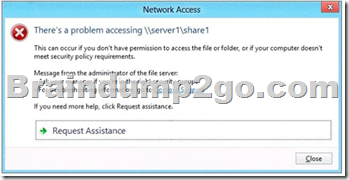
You deploy a new file server named Server2 that runs Windows Server 2012 R2.
You need to configure Server2 to display the same custom Access Denied message as Server1.
What should you install on Server2?
A. The Remote Assistance feature
B. The File Server Resource Manager role service
C. The Enhanced Storage feature
D. The Storage Services server role
Answer: B
Explanation:
We need to install the prerequisites for Access-Denied Assistance.
Because Access-Denied Assistance relies up on e-mail notifications, we also need to configure each relevant file server with a Simple Mail Transfer Protocol (SMTP) server address. Let’s do that quickly with Windows PowerShell:
Set-FSRMSetting -SMTPServer mailserver.nuggetlab.com -AdminEmailAddress [email protected] -FromEmailAddress [email protected]
You can enable Access-Denied Assistance either on a per-server basis or centrally via Group Policy. To my mind, the latter approach is infinitely preferable from an administration standpoint.
Create a new GPO and make sure to target the GPO at your file servers’ Active Directory computer accounts as well as those of your AD client computers. In the Group Policy Object Editor, we are looking for the following path to configure Access-Denied Assistance:
\Computer Configuration\Policies\Administrative Templates\System\Access-Denied Assistance
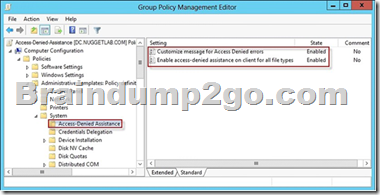
The Customize message for Access Denied errors policy, shown in the screenshot below, enables us to create the actual message box shown to users when they access a shared file to which their user account has no access.
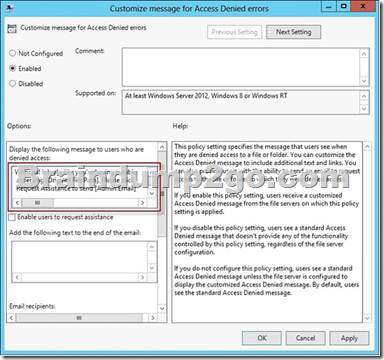
What’s cool about this policy is that we can “personalize” the e-mail notifications to give us administrators (and, optionally, file owners) the details they need to resolve the permissions issue quickly and easily.
For instance, we can insert pre-defined macros to swap in the full path to the target file, the administrator e-mail address, and so forth. See this example:
Whoops! It looks like you’re having trouble accessing [Original File Path]. Please click Request Assistance to send [Admin Email] a help request e-mail message. Thanks!
You should find that your users prefer these human-readable, informative error messages to the cryptic, non-descript error dialogs they are accustomed to dealing with.
The Enable access-denied assistance on client for all file types policy should be enabled to force client computers to participate in Access-Denied Assistance. Again, you must make sure to target your GPO scope accordingly to “hit” your domain workstations as well as your Windows Server 2012 file servers.
Testing the configuration
This should come as no surprise to you, but Access-Denied Assistance works only with Windows Server 2012 and Windows 8 computers. More specifically, you must enable the Desktop Experience feature on your servers to see Access-Denied Assistance messages on server computers.
When a Windows 8 client computer attempts to open a file to which the user has no access, the custom Access-Denied Assistance message should appear:
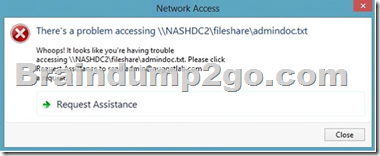
If the user clicks Request Assistance in the Network Access dialog box, they see a secondary message:

At the end of this process, the administrator(s) will receive an e-mail message that contains the key information they need in order to resolve the access problem:
The user’s Active Directory identity
The full path to the problematic file
A user-generated explanation of the problem
So that’s it, friends! Access-Denied Assistance presents Windows systems administrators with an easy-to-manage method for more efficiently resolving user access problems on shared file system resources. Of course, the key caveat is that your file servers must run Windows Server 2012 and your client devices must run Windows 8, but other than that, this is a great technology that should save admins extra work and end-users extra headaches.
http://4sysops.com/archives/access-denied-assistance-in-windows-server-2012/
QUESTION 286
Your network contains an Active Directory domain named contoso.com.
All domain controllers run Windows Server 2012 R2.
Administrators use client computers that run Windows 8 to perform all management tasks.
A central store is configured on a domain controller named DC1.
You have a custom administrative template file named App1.admx. App1.admx contains application settings for an application named Appl.
From a client computer named Computer1, you create a new Group Policy object (GPO) named GPO1.
You discover that the application settings for App1 fail to appear in GPO1.
You need to ensure that the App1 settings appear in all of the new GPOs that you create.
What should you do?
A. Copy App1.admx to \\Contoso.com\SYSVOL\Contoso.com\Policies\PolicyDefinitions\
B. From the Default Domain Controllers Policy, add App1.admx to the Administrative Templates.
C. From the Default Domain Policy, add App1.admx to the Administrative Templates
D. Copy App1.admx to \\Contoso.com\SYSVOL\Contoso.com\StarterGPOs.
Answer: A
Explanation:
To take advantage of the benefits of . admx files, you must create a Central Store in the SYSVOL folder on a domain controller. The Central Store is a file location that is checked by the Group Policy tools. The Group Policy tools use any . admx files that are in the Central Store. The files that are in the Central Store are later replicated to all domain controllers in the domain.
QUESTION 287
Your network contains an Active Directory domain named contoso.com. All domain controllers run Windows Server 2012 R2. One of the domain controllers is named DC1.
The DNS zone for the contoso.com zone is Active Directory-integrated and has the default settings.
A server named Server1 is a DNS server that runs a UNIX-based operating system.
You plan to use Server1 as a secondary DNS server for the contoso.com zone.
You need to ensure that Server1 can host a secondary copy of the contoso.com zone.
What should you do?
A. From Windows PowerShell, run the Set-DnsServerPrimaryZone cmdlet and specify the contoso.com
zone as a target.
B. From DNS Manager, modify the Security settings of DC1
C. From DNS Manager, modify the Zone Transfers settings of the contoso.com zone.
D. From DNS Manager, modify the Advanced settings of DC1.
Answer: A
Explanation:
Bind might be a must on Unix, but so is enabling Zone Transfer for it to be able to work at all. Default settings has it unmarked.
QUESTION 288
Your network contains an Active Directory domain named contoso.com. The domain contains a server named Server1 that runs Windows Server 2012 R2 and has the Network Policy Server role service installed.
You need to enable trace logging for Network Policy Server (NPS) on Server1.
Which tool should you use?
A. the Network Policy Server console
B. the Server Manager console
C. the tracert.exe command
D. the netsh.exe command
Answer: D
Explanation:
You can use log files on servers running Network Policy Server (NPS) and NAP client computers to help troubleshoot NAP problems. Log files can provide the detailed information required for troubleshooting complex problems.
You can capture detailed information in log files on servers running NPS by enabling remote access tracing. The Remote Access service does not need to be installed or running to use remote access tracing. When you enable tracing on a server running NPS, several log files are created in %windir%\tracing.
The following log files contain helpful information about NAP:
IASNAP.LOG: Contains detailed information about NAP processes, NPS authentication, and NPS authorization.
IASSAM.LOG: Contains detailed information about user authentication and authorization.
Membership in the local Administrators group, or equivalent, is the minimum required to enable tracing. Review details about using the appropriate accounts and group memberships at Local and Domain Default Groups
(http://go.microsoft.com/fwlink/?LinkId=83477).
To create tracing log files on a server running NPS
Open a command line as an administrator.
Type netshras set tr * en.
Reproduce the scenario that you are troubleshooting.
Type netshras set tr * dis.
Close the command prompt window.
http://technet.microsoft.com/en-us/library/dd348461%28v=ws.10%29.aspx
QUESTION 289
Hotspot Question
Your network contains an Active Directory forest named contoso.com. The forest contains a single domain. The forest contains two Active Directory sites named Site1 and Site2.
You plan to deploy a read-only domain controller (RODC) named DC10 to Site2.
You pre- create the DC10 domain controller account by using Active Directory Users and Computers.
You need to identify which domain controller will be used for initial replication during the promotion of the RODC.
Which tab should you use to identify the domain controller? To answer, select the appropriate tab in the answer area.
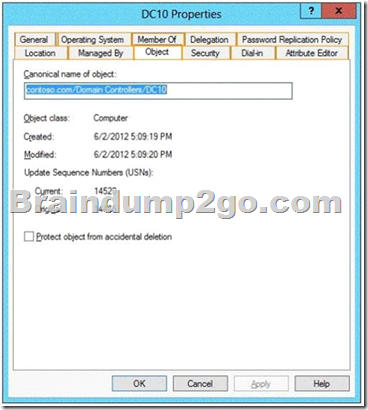
Answer:
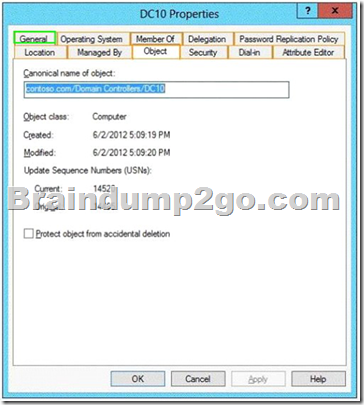
QUESTION 290
Your network contains an Active Directory domain named contoso.com. The domain contains a server named Server1 that runs Windows Server 2012 R2 and has the DNS Server server role installed.
Server1 is configured to delete automatically the DNS records of client computers that are no longer on the network. A technician confirms that the DNS records are deleted automatically from the contoso.com zone.
You discover that the contoso.com zone has many DNS records for servers that were on the network in the past, but have not connected to the network for a long time.
You need to set the time stamp for all of the DNS records in the contoso.com zone.
What should you do?
A. From DNS Manager, modify the Advanced settings from the properties of Server1
B. From Windows PowerShell, run the Set-DnsServerResourceRecordAging cmdlet
C. From DNS Manager, modify the Zone Aging/Scavenging Properties
D. From Windows PowerShell, run the Set-DnsServerZoneAging cmdlet.
Answer: D
Braindump2go New Released 70-411 Dumps PDF are Now For Free Download, 322 Latest Questions, Download It Right Now and Pass Your Exam 100%:
FREE DOWNLOAD: NEW UPDATED 70-411 PDF Dumps & VCE Dumps from Braindump2go: http://www.braindump2go.com/70-411.html (322 Q&As)
